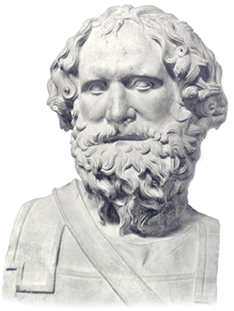...Best of Sicily presents... Best of Sicily Magazine. ... Dedicated to Sicilian art, culture, history, people, places and all things Sicilian. |
by Vincenzo Salerno | |||
Magazine Index Best of Sicily Arts & Culture Fashion Food & Wine History & Society About Us Travel Faqs Contact Map of Sicily
|
When Archimedes was born, Greek was still the scholarly and vernacular language of most of the central and eastern Mediterranean, but the rapidly expanding Roman Empire sought to annex Sicily to its dominions, in the process amalgamating Greek culture with its own. Archimedes was thus called upon to construct war machines which held back the Romans' siege of Syracuse for three years. One story says he created an apparatus using convex lenses and mirrors which concentrated the sun's rays on the enemy ships and set them afire. This could be legend, but historians agree that Archimedes would have had the creativity and ability to devise such a mechanism. Experimentation yielded "Archimedes' Principle" that a body immersed in fluid loses as much weight as the weight of the liquid it displaces. This is a fundamental principle of buoyancy. Using water displacement in this way, Archimedes demonstrated that Hieron's crown was not made of solid gold. Realising his discovery's validity but forgetting to dress before leaving the pool where he was experimenting, he ran down the streets of Syracuse naked shouting the now famous phrase "Eureka!" ("I've found it.") "Give me a place to stand and I'll move the Earth." Archimedes' boast became a fundamental principle of mechanics that states that a great weight can be moved by a small force using levers and other means. The water screw he devised for irrigation is still copied and used in parts of Egypt, and it was used in ancient and medieval Sicily as well. While characteristically deep in thought, Archimedes was killed by a Roman soldier during the siege of Syracuse in 212 BC. Marcellus, the Roman general, had given an order that Archimedes be spared at all costs, but the ignorant soldier stabbed him while the genius was drawing a mathematical figure in the sand. An accurate likeness of Archimedes is not known. The bust shown here (and preserved in a Neapolitan museum), believed by many to have been Archimedes, is actually Archidamos II of Sparta, who died in 338 BC. It is, however, no more fanciful an image of Archimedes than many artistic representations created over the centuries, and has found its way onto coins, postal stamps and other places. Not all his recorded work survives, but Archimedes' accomplishments are legion, and today are known to any student of physics, mathematics, architecture, geometry or engineering. The "father of integral calculus," Archimedes invented the compound pulley. In geometry, Archimedes' method of exhaustion, refining the earlier work of Euclid and Eudoxus, was so accurate that in some cases it was equal to integration. The general principle of hydrostatics was established by Archimedes in his treatise "On Floating Bodies." His work "The Sand Reckoner" proposes a novel method of expressing large numbers. "The Method" sets forth equations and formulae based on logic. "Measurement of the Circle" establishes the value identified as "pi" (approximately 3.14) in determing the ratio of circumference to a diameter within narrow limits. In practice, pi is a constant element in many mathematical problems. "On Spirals" establishes proportions concerning the curve now called the "spiral of Archimedes." Certain lost works may have yielded a more complete knowledge of Archimedes' theories. "On Balances and Levers" could have told us more about "Archimedes' boast" to move the earth. "Catoptrica" dealt with, among other things, the refraction of light, and is quoted by Theon of Alexandria. "On Sphere Making" demonstrated the constructions of spheres showing the movements of celestial bodies and implies that Archimedes probably believed the Earth to be round, a theory expressed in medieval Arab-Norman Sicily, in China and elsewhere. Many of Archimedes' ideas found their way into Near Eastern science and engineering. His contributions to geometry greatly aided the development of ballistics, applied physics and, eventually, space exploration. He was a Renaissance Man long before the Renaissance. Carl Sagan (1934-1996), a brilliant cosmologist and astrophysicist who popularized science, suggested that, had it not been for the wars, social conflicts and other distractions arising from the expansion of the Roman Empire and then (as it developed) Christianity, the scientific principles introduced by Archimedes and others in the Greek world would have led to a more rapid development of technology. Moreover, the philosophy of Plato and other thinkers might have complemented these scientific advances. According to Sagan's theory, the moon landing might have been accomplished in 1069 instead of 1969, with the astronauts speaking classical Greek. About the Author: Palermo native Vincenzo Salerno has written biographies of several famous Sicilians, including Frederick II and Giuseppe di Lampedusa. | ||
Top of Page |
 Little is known of his personal life, and the figure shown
here, widely purported to be Archimedes, isn't even him (more
about that later), but Archimedes changed the course of scientific
history. This mathematician, physicist and engineer was born around
287 BC (BCE) in
Little is known of his personal life, and the figure shown
here, widely purported to be Archimedes, isn't even him (more
about that later), but Archimedes changed the course of scientific
history. This mathematician, physicist and engineer was born around
287 BC (BCE) in